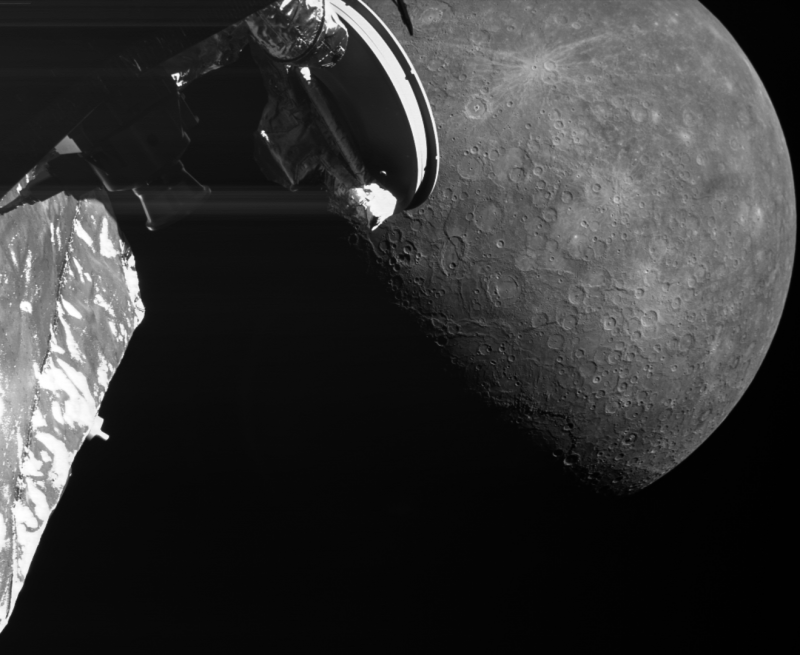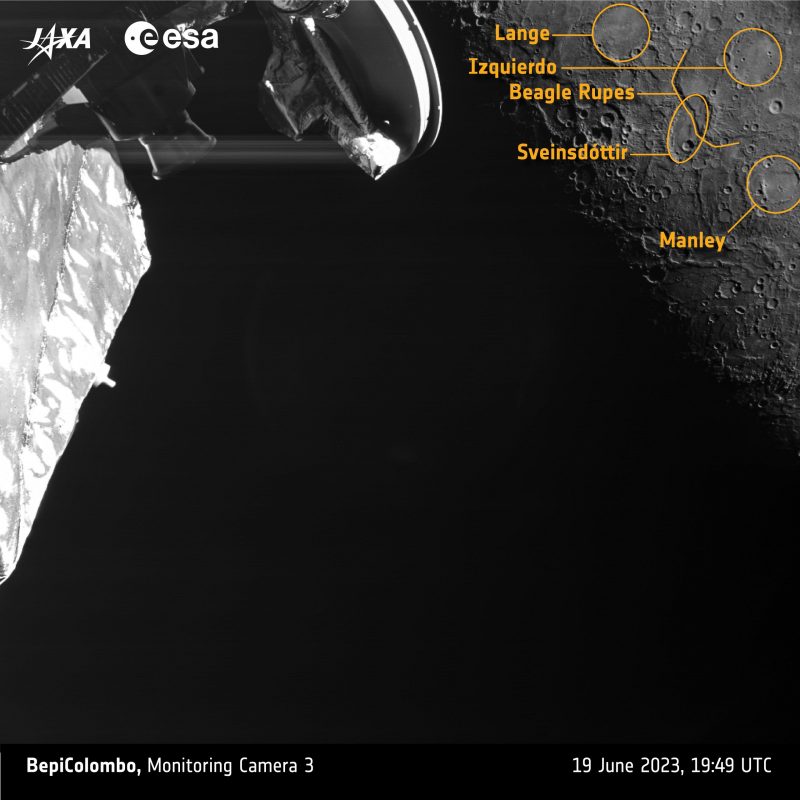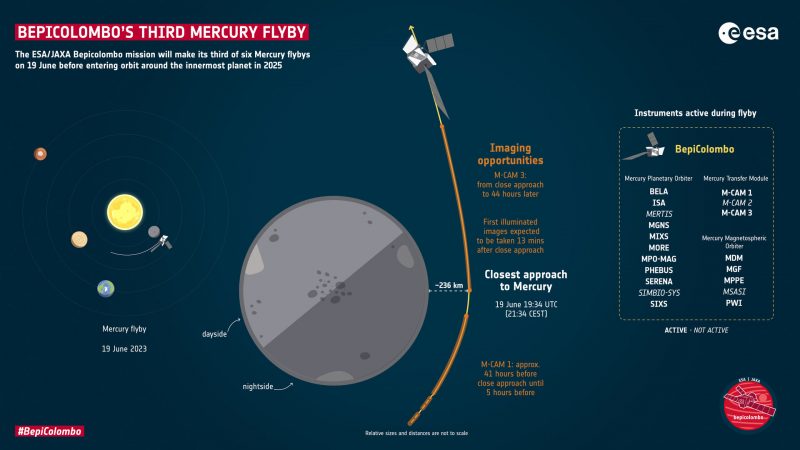In this new video, we see a series of images as BepiColombo speeds away from the closest planet to the sun during the 3rd Mercury flyby. The spacecraft captured these images in a span of about 50 minutes. Video via ESA.
New images of Mercury from BepiColombo flyby
On June 20, 2023, ESA released new images of Mercury after BepiColombo spacecraft flew past the closest planet to the sun the day prior. In these images, we get to see a part of BepiColombo with cratered Mercury in the background. ESA released a trio of images as the spacecraft zoomed away during a gravity assist maneuver. It also released annotated images to point out important surface features.





Reactions from the BepiColombo team
The team involved with the BepiColombo mission were satisfied with the flyby and resulting images. Ignacio Clerigo, ESA’s BepiColombo Spacecraft Operations Manager, said:
Everything went very smoothly with the flyby, and images from the monitoring cameras taken during the close approach phase of the flyby have been transmitted to the ground. While the next Mercury flyby isn’t until September 2024, there are still challenges to tackle in the intervening time: our next long solar electric propulsion ‘thruster arc’ is planned to start early August until mid-September. In combination with the flybys, the thruster arcs are critical in helping BepiColombo brake against the enormous gravitational pull of the sun before we can enter orbit around Mercury.
One of the craters visible in the images is the newly named Manley crater. The International Astronomical Union (IAU) named this crater for Jamaican artist Edna Manley (1900–1987). David Rothery of the BepiColombo team said:
During our image planning for the flyby, we realized this large crater would be in view, but it didn’t yet have a name. It will clearly be of interest for BepiColombo scientists in the future because it has excavated dark ‘low reflectance material’ that may be remnants of Mercury’s early carbon-rich crust. In addition, the basin floor within its interior has been flooded by smooth lava, demonstrative of Mercury’s prolonged history of volcanic activity.
You can learn more about these new images here.
BepiColombo 3rd Mercury flyby June 19, 2023
BepiColombo made its third flyby of the planet Mercury on June 19, 2023. The spacecraft swept closest to Mercury at 19:34 UTC (2:34 p.m. CDT).
BepiColombo is a joint Mercury mission, launched in October 2018 by the European Space Agency (ESA) and the Japan Aerospace Exploration Agency (JAXA). For the past several years, our sun’s inner planets have been giving BepiColombo gravity assists, needed to enable the spacecraft to achieve a stable orbit around Mercury.
BepiColombo is due to enter Mercury’s orbit on December 5, 2025. In the meantime, there will be three more flybys after Monday’s close approach.
Why the gravity assists?
Why can’t BepiColombo just shoot on over to Mercury and go into orbit around it? It can’t because Mercury is so near the sun.
The flyby maneuvers will keep the craft from being pulled into the sun’s gravity well. With one Earth flyby, two Venus flybys, and six eventual Mercury flybys, the spacecraft will lose enough energy that Mercury will capture it in its orbit. That’s right, we said “lose.” We typically think of a gravity assist as a way to boost a spacecraft’s energy. But a gravity assist can either speed up or slow down a spacecraft. Or it can simply change a craft’s direction.
ESA flight dynamics expert Frank Budnik explained more about this 3rd flyby:
As BepiColombo starts feeling Mercury’s gravitational pull, it will be traveling at 3.6 km/s [2.2 mi/s] with respect to the planet. That’s just over half the speed it approached with during the previous two Mercury flybys.
And this is exactly what the point of such events is. Our spacecraft began with far too much energy because it launched from Earth and, like our planet, is orbiting the sun. To be captured by Mercury, we need to slow down, and we’re using the gravity of Earth, Venus and Mercury to do just that.

Tricky maneuvering
Even though BepiColombo’s flight to Mercury was meticulously mapped in advance, controllers will have to make corrections during the seven years it’ll take the spacecraft to get there. In May, mission control performed a course correction that otherwise would have put BepiColombo 15,000 miles (24,000 km) too far from Mercury and on the wrong side of the planet.
Santa Martinez Sanmartin, ESA’s BepiColombo mission manager, explained more about the methods used to get BepiColombo in orbit:
This is the first time scientists are using the complex solar electric propulsion method to get a spacecraft to Mercury. And it represents a big challenge during the remaining part of the cruise phase. We have already adapted our operations concept to have additional communications passes with our ground stations, enabling us to recover faster from thruster interruptions and to improve orbit determination.
And all the while this is working with communications delays of more than 10 minutes due to the time it currently takes light signals to travel between Earth and the spacecraft.
As ESA said, the most demanding part of its journey is still to come:
After this flyby, the mission will enter a very challenging part of its journey to Mercury, gradually increasing the use of solar electric propulsion through additional propulsion periods called ‘thrust arcs’ to continually brake against the enormous gravitational pull of the sun. These thrust arcs can last from a few days up to two months, with the longer arcs interrupted periodically for navigation and maneuver optimization.
This challenging journey is one of the reasons that Mercury is one of the least explored planets in our solar system.
The images from the 3rd Mercury flby
BepiColombo got as close as 146 miles (235 km) from Mercury’s surface during this flyby. However, closest approach was past the unlit portion of Mercury, so scientists didn’t capture any images until a bit later. At about 13 minutes past closest approach, when the spacecraft was 1,143 miles (1,840 km) away, it reached the illuminated part of Mercury. Then it began sending back black-and-white images, including part of the craft itself. A Mercurial selfie, if you will.
You can follow along with the #MercuryFlyby at these Twitter accounts: @esaoperations, @BepiColombo, @ESA_Bepi, @ESA_MTM and @JAXA_MMO.

Testing the instruments
The team uses these flybys as a chance to test some of the instruments. During Monday’s flyby, the magnetic, plasma and particle monitoring instruments sampled the environment. Johannes Benkhoff, project scientist, said:
Collecting data during flybys is extremely valuable for the science teams to check their instruments are functioning correctly ahead of the main mission. It also provides a novel opportunity to compare with data collected by NASA’s MESSENGER spacecraft during its 2011–2015 mission at Mercury from complementary locations around the planet not usually accessible from orbit. We are delighted to already have data published based on our previous flybys that generated new science results, which makes us even more excited to get into orbit!

Bottom line: BepiColombo had its 3rd flyby of Mercury on June 19, 2023. The spacecraft will eventually go into orbit around the closest planet to the sun. ESA released three new images of Mercury taken during the encounter.











